by Jarrett Hoffman

The parallel between German reunification and the hope for peaceful reunification of Korea took physical form in late 2015 with the construction of Berlin’s Pavillon der Einheit (Pavilion of Unity).
It was around that same time when Kim met Korean-born Dayoung Yoon, who plays the gayageum, a traditional Korean zither. They started talking at a concert organized by the Korean Cultural Center in Berlin, and hit it off over a shared interest in creating music.
“That was my first real encounter with a Korean traditional instrument,” said Kim, who was born in Austria, with Korean roots. “And actually she was having quite a hard time in Berlin, because it’s not easy for a Korean person to get used to the Berlin vibe. Then she met me, and everything turned around because we were making music together.”
It wasn’t long before the duo known as CelloGayageum, conceived around the idea of unity between the global East and West, was racking up a resume: albums of all original music, and honors such as the Soorim Culture Prize, a grant from the Seoul Foundation of Arts and Culture, and the Artist of the Year award from Seoul’s Jeongdong Theater.
And they recently arrived in the U.S. for a month-long tour, their longest yet, that will include their Cleveland debut: a performance at the Cleveland Museum of Art’s Gartner Auditorium on Wednesday, February 14 at 7:30 pm. Tickets are available here.
The concert will be preceded by a 6:00 conversation between the duo and Sooa Im McCormick, Curator of Korean Art at CMA, about the influence of traditional Korean music on their works. Also tied in are two exhibitions of Korean art on the horizon: “Into the Seven Jeweled Mountain” (March 15 – September 19) and “Korean Couture: Generations of Revolution” (April 28 – October 13).
I spoke with Sol Daniel Kim on Zoom just before the start of the duo’s tour, he and Dayoung Yoon having just flown in from Seoul. And after discussing the Pavilion of Unity and his first meeting with Yoon, we dug into the musical meshing of cello and gayageum.

But as I was listening to your music, something else that really struck me is the range of percussive sounds that you’re both able to make. Could you talk a little bit about that?
Sol Daniel Kim: So the first time we sat together and played, we immediately realized that we should try to expand our sounds beyond the things we were used to doing on our instruments, because that was going to make it more interesting.
And since I was a percussion enthusiast — I was a hobby drummer — I thought, why not treat my instrument as a percussion instrument? Like, why not hit it? Nobody does, maybe first of all because nobody really thinks about it, and second of all because it’s really expensive. But I thought, if I’m just cautious enough, I can maybe make it work.
JH: I also noticed that sometimes when you pluck the strings, that maybe you’re deadening them, making the sound come across as even more percussive somehow.
SDK: Absolutely. I said I was a hobby drummer, but I was also a hobby guitarist. I was trying stuff out on the guitar when I was younger — certain techniques that I thought might translate to cello as well at some point. You study for over twenty years how to bow the cello, and they never teach you how to pluck it — it’s like, ‘Just pluck it until it sounds nice.’
I was having a fun time with guitar, figuring things out via YouTube and through friends, and I thought, ‘Hey, that’s nice how there are so many different techniques on the guitar — why don’t we use those on the cello?’ But I never got to use those skills until I met Dayoung and we made our own duo. So trying to find new techniques to make sounds that weren’t made in a classical sense was very fun for me.
JH: I was also noticing that the beat often has this great hypnotizing feeling. I know that one of the big ideas behind your duo is combining classical music and Korean traditional music, but I get the feeling there are influences from pop and minimalism as well. Was that intentional?
SDK: That’s absolutely intentional. With our music, we like to explore new ways of working with different materials, and creating something new through that. And we thought, why not open up our perspective by bringing in other styles of music — things like pop, minimalism, jazz, modern, contemporary — and blending them together in a way that sounds nice to us?
We wanted to make music that appeals to people, but first of all, we thought we should write something that we would enjoy together, that we would want to listen to multiple times — not just write a piece, play it, and be done with it. And we thought, maybe if our music is good enough, then other people will start to follow it as well.
JH: And I imagine that it does appeal to a lot of people. I love it, and I think if I showed it to my friends who don’t know a lot about music, they would too. Another part of that is your music videos, which are very stylish, very cool, very artistically produced. Tell me about how those get made.
SDK: The music videos are something very special for us. Of course, music video production is really expensive. We got lucky — we applied for funding for that, and since all the government programs for Korean traditional music already knew about us and liked our music, they were very supportive. They said, ‘Okay, we’re going to give you the funding — make something cool.’
Our agency has a lot of connections to other artists, so all these ideas for the videos weren’t just from us. We had a lot of help, and I think that’s what making art is about. Not just being by yourself — it’s about having a lot of people around you, a lot of nice people, and trying to create something together. And that’s how those videos came to be.
JH: I also want to ask about the composition process, because the two of you play all original music. Do you compose separately, or together — how does it work?
SDK: I would describe it as a cooperative design process. Basically one of us comes up with a riff, a pattern, or an idea. And then we brainstorm with it, sitting down for one or two hours and jamming on it, coming up with ideas and figuring out how to implement them. After we have enough ideas, we try to shape it all into a form that makes sense.
And from there, we’re just shaping it until it’s perfect. Adding, removing — but actually removing a lot more than adding. I think adding something is pretty easy, but removing it in a way that it all makes sense for everybody who’s listening is kind of hard, especially for me. I’m a guy who likes to talk a lot, and that kind of makes its way into the music. And then Dayoung will always suggest that we get rid of things so that people can follow the ideas. It’s a good balance that we have between each other.
JH: It’s been great talking to you, and I hope you have a great tour — a long tour, right?
DSK: Yes, absolutely. We’re quite thrilled and also a little bit scared at the same time, because it’s our first big tour ever. We’ve always dreamt of something like this, and now that it came to life, we’re like, ‘Oh my god, is this happening?’
First and second photos by Nah Seung Yull
Published on ClevelandClassical.com February 7, 2024.
Click here for a printable copy of this article




